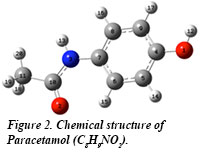 The study of the behavior of polymorphic organic solids at high pressure is a relatively new and rapidly growing area of interest. The applications span a wide ranging field which includes the pharmaceutical industry, where often times different crystal phases of the same drug can have different physiological effects.
The study of the behavior of polymorphic organic solids at high pressure is a relatively new and rapidly growing area of interest. The applications span a wide ranging field which includes the pharmaceutical industry, where often times different crystal phases of the same drug can have different physiological effects.
 CDAC Graduate Student Spencer Smith, along with CDAC Academic Partner Yogesh Vohra and colleagues from the University of Alabama - Birmingham, used diamond anvil cell technology, Raman spectroscopy, synchrotron x-ray diffraction, and multiple ab initio harmonic frequency calculations to explore the solid-state transition behavior of Paracetamol (a commonly used analgesic and anti-pyretic) at hydrostatic pressures up to 21 GPa.
CDAC Graduate Student Spencer Smith, along with CDAC Academic Partner Yogesh Vohra and colleagues from the University of Alabama - Birmingham, used diamond anvil cell technology, Raman spectroscopy, synchrotron x-ray diffraction, and multiple ab initio harmonic frequency calculations to explore the solid-state transition behavior of Paracetamol (a commonly used analgesic and anti-pyretic) at hydrostatic pressures up to 21 GPa.

Spectral measurements provide further evidence for a highly kinetically driven Form I --> II transition occurring as a mixed phase from 4.8 to 6.5 GPa, as well as new evidence for previously unobserved Form IV and Form V occurring at pressures of 8.1 and 11 GPa, respectively [S. J. Smith et al., J. Phys. Chem. A, DOI: 10.1021/jp411810y (2014)].
